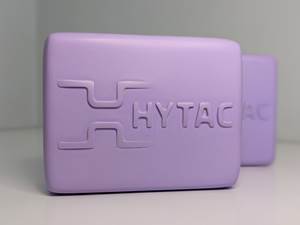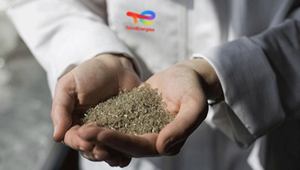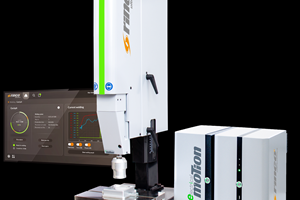Learning to Master In-Mold Labeling
As in-mold labeling, or IML, attracts a growing following among U.S. molders, some are finding that mastering a complex new technology is no small task.
As in-mold labeling, or IML, attracts a growing following among U.S. molders, some are finding that mastering a complex new technology is no small task. That was the case last year, when the Temecula, Calif., operation of The Scotts Miracle-Gro Co. chose IML for an upgraded line of lawn and garden equipment. Scotts completely revamped its wheeled spreaders for fertilizer, seed, or ice-melting products. Scotts wanted to improve their look with new graphics. The new “dashboard” control panel on the injection molded hopper uses a lot of small text in both heavy and light fonts. A second graphic carries the Scotts logo.
While hot stamping was chosen for the simpler graphics of the entry-level spreader model, the more complex graphics with up to five colors on the deluxe model eliminated hot stamping, according to engineering manager Tom Shappie. Even for the mid-level model, Shappie was not sure Scotts could get consistent high-quality graphics with hot stamping or heat-transfer labeling.
“Hot stamping has inherent inconsistency. If the hot stamp is too hot or too cool, you don’t get correct transfer of the graphic. The hot-stamp pad wears out over time, which requires a QC check of each part,” says Shappie. Scotts also considered pressure-sensitive labels before deciding on IML.
Jumping IML hurdles
Temecula had to convert three of its 40 injection presses for IML. “We could not afford to idle our molding and assembly labor, and we had to continue delivering product to customers,” notes Shappie. Scotts assembled a team including Shappie, tooling lead Ken Bowers, molding process specialist Skip Waldo, and quality manager David Patrick. Their strategy was to focus on one manufacturing cell at a time—shut it down and set up its new robot, end-of-arm tooling (EOAT), mold, IML magazines, and assembly line.
Challenges presented themselves almost immediately. The team realized that their “turnkey” IML installation was anything but that. They would have to develop IML expertise on their own.
While IML was expected to take only 10% of the total project implementation time, it became the biggest challenge. “We dedicated a technician to IML 24 hours a day,” Shappie recalls. The IML equipment vendor estimated three days to debug the system and predicted scrap levels of 1% to 3%. It took several weeks and much higher initial scrap rates.
One problem was variation in the labels—from die-cutting accuracy to inks, texture, and finish. Finding a dependable label vendor became a priority. Scotts chose Central Decal in Chicago. “A consistent label can determine whether you mold a good part or a bad part,” says Patrick. “The ink, coating, and curing are all significant.”
The label magazine didn’t consistently present one label to the robot at a time. The solution was to redesign the magazine faceplate, change the label coating, and manually fan the labels before loading them into the magazine. Bowers modified the magazine faceplate with a 5° taper to funnel the label to an exact position. The opening on the pickup end is 0.005 in. smaller than the label, causing the label to bow slightly in the middle for easier pickup by the robot and positive separation from the next label in the stack. Bowers also contoured the antistatic pad of the EOAT to ensure positive placement of labels in the mold.
Scotts uses a label-charging system from Simco Industrial Static Control, Hatfield, Pa. “It is important how you charge the label,” notes Bowers. “Where you charge, when, how much, and at what distance from the label to the charger all have an impact.” A critical factor is applying sufficient static charge to the label to pin it to the mold. Scotts had to adjust the way one of the labels was charged, since it was printed with black ink on one end and orange on the other. The black ink contained carbon, a conductor, which resulted in a weaker charge.
Scotts also found it important to use a servo-driven robot for repeatable label pickup and placement. Scotts uses a Sytrama linear servo robot from AEC Inc., Schaumburg, Ill. Bowers helped redesign the EOAT to make it more rugged and repeatable.
Since the IML molds could not be gated directly behind the label, sequential valve gating was required to move the weld line away from the labels.
Related Content
High-Temperature Syntactic Foam and High-Slip Plug Materials for Thermoforming
At K 2022, CMT Materials to launch new Hytac syntactic foam and a developmental higher slip plug materials with no PTFE.
Read MoreOMV Technologies Gets New CEO
Kooper brings 33 years of experience in the industrial and consumer packaging industries to OMV--the closed-loop, turnkey, inline extrusion, thermoforming and tooling systems manufacturer.
Read MoreS&B Selected as Contractor for New Hope Energy Advanced Plastics Recycling Unit
New Hope Energy and Total Energies collaboration for an advanced plastics recycling unit gains momentum.
Read MoreNext-Generation Fully Electric Ultrasonic Welding System
NPE 2024: Rinco new eMotion servo-driven machine is available in 20 kHZ and 35 kHz frequencies.
Read MoreRead Next
How Polymer Melts in Single-Screw Extruders
Understanding how polymer melts in a single-screw extruder could help you optimize your screw design to eliminate defect-causing solid polymer fragments.
Read MoreLead the Conversation, Change the Conversation
Coverage of single-use plastics can be both misleading and demoralizing. Here are 10 tips for changing the perception of the plastics industry at your company and in your community.
Read MoreWhy (and What) You Need to Dry
Other than polyolefins, almost every other polymer exhibits some level of polarity and therefore can absorb a certain amount of moisture from the atmosphere. Here’s a look at some of these materials, and what needs to be done to dry them.
Read More

























